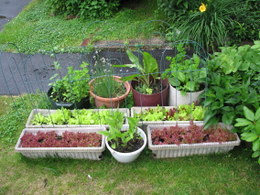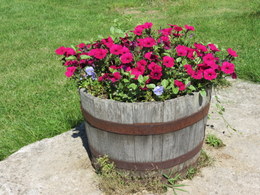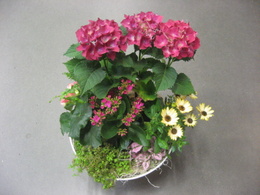Container Garden Growing Guide
Containers are the best way to get started if you just moved into a new home, lack the room or have poor soil.
If you live in a condo you have to abide by the restrictions placed on you. If you have a patio or a deck you should be able place them there. You may also be allowed to use a small area that you can plant in. Before you do any planting in the ground check first to see what the rules are and what you can or cannot do.
There are many varieties of flowers available in garden centers that will do well in containers. See how much sunlight your area gets and select the flowers that are best suited for your location. There are flowers that require full sun, part sun and shade.
Vegetables will also do well growing in a containers. Growing your own vegetables and herbs is the best way to get the freshest and flavorful vegetables and herbs that you cannot find in a grocery store.
Containers
Almost anything can be used as long as it has proper drainage holes in the bottom. Large clay pots, window boxes, half-wine barrels and 5-gallon buckets with holes drilled in the bottom are all good choices to get started container gardening.
Heavy containers are hard to move and should be placed on a plant stand with wheels. Many styles and sizes are available. A mover’s furniture dolly will support even the heaviest ones.
It is important to place a saucer under your potted plants to protect your patio or deck from staining. If the saucer fills with water from watering or rain it should be emptied to prevent the plants from getting waterlogged.
If the saucer has water in it the next day that is a good indication that the soil has taken in all of the water it can and it should be removed. Your pot might be too heavy to pick up. so a turkey baster can be used to remove the excess water from the saucer.
Flowers
Annuals are the most common flowers for container gardens and hanging baskets. They tend to bloom quickly and continue all summer long. If you are in a hurry and do not have the time your local garden center usually has an assortment of hanging baskets for sale.
Window boxes that sit on the railing of a deck are a very popular form of container garden and are very attractive. Vining plants that spill out and hang over the edge will add some added interest to your window box or hanging basket.
Look for trailing plants such as Lobelia that will spill over the rim of your window box or hanging basket. It comes in various shades of blue, pink and white and will hang 12 to 24-inches.Other popular spillers are calibrachoa, which comes in blue, pink, red, yellow and white, and bacopa (Sutera cordata) which blooms in blue, pink lavender and white, as well as the ever popular Sweet Potato Vines.
Other popular container garden flowers are: astilbe, begonias, caladium, coleus, coral bells/heuchera, euphorbia, fuchsia, geraniums, impatiens, marigold, mums, nemesia, pansy, petunia, salvia, snapdragon, verbena and zinnia.
Flowering shrubs such as azalea and hydrangea can be grown in containers.
Floral Arrangements
One good design feature of a floral arrangement is to use the “Thriller, Filler, Spiller” concept. This design technique is to place taller upright plants to the rear or center of the container and lower spreading filler plants surrounding the thriller, followed by the spiller vining plants that spill out and hang over the edge.
Place the thriller in the center of the container if it will be viewed from all sides and to the rear if viewed from one side such as a window box.
Thrillers can either be flowering or foliage plants or ornamental grasses. Look for varieties that grow between 12 and 18 inches tall.
Some thriller examples are: angelonia, celosia, geraniums, lantana, nicotiana, pentas lanceolate and purple fountain grass (Pennisetum setaceum ‘Rubrum’).
After you have chosen your thriller you can look for your filler. These are usually placed in front of or around the thriller. The fillers are varieties that are lower than the thriller and fill in the container. Look for varieties that grow between 6 and 12 inches tall.
Some filler examples are: ageratum, angelonia, begonia, coleus, dusty miller, geranium, impatiens, lantanas and pentas. Don’t be afraid to try mixing and matching what you have.
Now we get to the spiller which can be any type of ivy, alternanthera, bacopa, nasturtiums, pothos as well as the popular sweet potato vines.
Vegetables
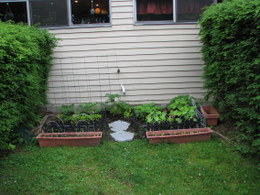
In the spring the garden centers will carry a wide selection of popular and easy-to-grow vegetables that are suited for container gardening. Look at the plant labels carefully. If you see ‘Great for Containers’ on the label, that would be a good choice to make. If you are looking for some expert advice a full service garden center would be the best place to go.
A small container garden can easily be grown on a porch or patio. Self-watering patio planters are especially designed to allow you to successfully grow many kinds of vegetables, herbs and flowers.
There are also durable fabric bags often called ‘Grow Bags’ that come in many colors and sizes from 5-gallons to 100-gallons. The instructions will often tell you how much potting mix you will need for your container garden.
Growing vegetables and flowers in containers such as woven baskets goes back to ancient times.
Patio planters and grow bags are available from Gardener's Supply Company and other retailers.
The best vegetables for container gardens are the ones that allow you to have a continuous harvest during the growing season. Lettuce, tomatoes, cucumbers, Swiss chard, spinach and most herbs are good examples of continuous harvest vegetables and are a good use of your limited space.
Broccoli, cauliflower, cabbage and onions are vegetables that take a season to grow and give you a single harvest at the end of the season. These are usually not a good use of your limited space.
When you are selecting vegetables, look for the “bush” varieties for your containers. The bush varieties are smaller and more compact than the vining varieties and are more suitable for container gardens. Tomatoes and cucumbers are a couple of examples that come in “bush” and “vining” varieties. If you select a nice compact, bush variety you will be happy with your container garden, but if you select a vining variety, you will have trouble controlling a tomato or cucumber plant that can grow more than 10-feet long.
Most of the vining vegetables in the squash and melon family are not suitable for container gardening.
Herbs
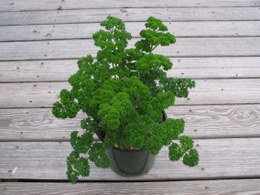
Basil, chives, cilantro, marjoram, mint, oregano, parsley, rosemary, sage, tarragon and thyme can be easily grown outside in container gardens.
As winter approaches many of these herbs can be brought indoors and placed in a very sunny window or under fluorescent lights.
Fruits
Many of the fruiting bushes or shrubs such as blueberries, figs, currents and gooseberries can be grown in containers.
Container Garden Mix
Use a good quality potting mix for your container garden. Many of the potting mixes already have a slow release fertilizer in it.
Make sure that you use the proper size container for your container garden. A single tomato plant can be grown in a 5-gallon bucket, which is about 12-inches in diameter. If you are using a larger self-watering patio planter you can plant 2-tomatoes in it.
In rural areas you may find some container garden oddities such as livestock watering troughs, old work boots, toilet, bathtub, wheelbarrow as well as an old tire from a car or tractor.
Watering and Care
Your container garden plants need to be checked frequently to be sure that they do not dry out or get water-logged from too much water. Plants in containers have a fixed amount of potting soil that they can draw moisture from. Your container garden plants that are in full sun will require more water than those in a shadier location. A windy location will also dry out your container garden plants.
If you get in the habit of sticking your finger into the soil of your container garden as you pass by you can easily determine if your plants need water. The top inch or two of the soil should be damp, not too dry or wet. Also remember that different plants have different watering requirements.
Even if you used a potting soil with a slow release fertilizer in your container garden you should use a liquid fertilizer when you water your plants. The fertilizer container label will give the information you need as to the amount and how often to use. Remember that vegetables and flowers are heavy feeders and will benefit from the addition of some extra plant food.
Garden Spikes newsletters give you timely information once or twice a month. Subscribe Free to the Garden Times newsletter below.
Your email address will only be used to send you a newsletter and will never be sold. You can unsubscribe at any time.
